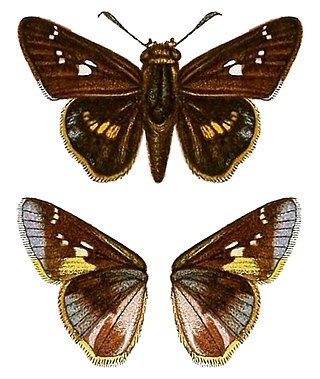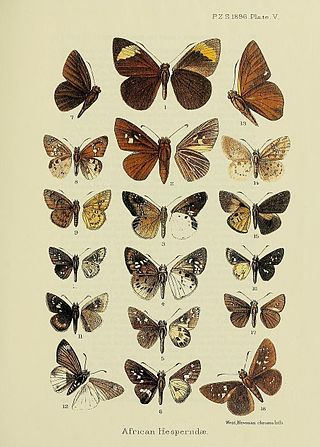
Platylesches is a genus of skipper butterflies in the family Hesperiidae, commonly called hoppers, found in Africa.

Coeliades forestan, the striped policeman, is a butterfly of the family Hesperiidae. It is found from Transkei to Zimbabwe and to Botswana. It is also present on Madagascar and Mauritius.
Platylesches ayresii, the peppered hopper, is a butterfly of the family Hesperiidae. It is found in bushveld in Botswana, western Transvaal, KwaZulu-Natal, Mozambique and Zimbabwe. The habitat consists of dry savanna and grassland.

Platylesches galesa, the white-tail hopper or black hopper, is a butterfly of the family Hesperiidae. It is found in Transvaal, Mozambique and Zimbabwe. It is common in forest and woodland.
Platylesches dolomitica, the hilltop hopper, is a butterfly of the family Hesperiidae. It is only known from dolomite ridges near Steelpoort in Mpumalanga, Horns Nek near Pretoria and Carletonville in Gauteng. The habitat consists of dolomite ridges in bushveld and sour grassland.

Platylesches robustus, the robust hopper or large hopper, is a butterfly of the family Hesperiidae. It is found in Zululand, Eswatini, Transvaal, Mozambique and Zimbabwe. The habitat consists of moist, frost-free savanna and the transitional zone between forest and Guinea savanna.

Platylesches moritili, the honey hopper or common hopper, is a butterfly of the family Hesperiidae. It is found in Africa. In South Africa, it is found from KwaZulu-Natal, north along the coast and hinterland to Maputaland and from Mpumalanga to northern Gauteng and from the central Limpopo Province to Pafuri. The habitat consists of savanna and riverine forest.
Platylesches tina, the small hopper, is a butterfly of the family Hesperiidae. It is found in Uganda, western Kenya, Malawi, Zambia, Zimbabwe, Namibia (Caprivi) and the Transvaal. The habitat consists of well-wooded savanna and riverine vegetation.
Platylesches picanini, the banded hopper, is a butterfly of the family Hesperiidae. It is found in Senegal, Gambia, Guinea, Sierra Leone, Liberia, Ivory Coast, Ghana, Nigeria, Cameroon, the Democratic Republic of the Congo, Uganda, south-western Kenya, Tanzania, Malawi, northern Zambia, Mozambique, Zimbabwe and South Africa. The habitat consists of forests, riparian vegetation along river courses, woodland, dry forests and Guinea savanna.

The Erionotini are a tribe of skipper butterflies in the subfamily Hesperiinae.
Platylesches affinissima, the bashful hopper or affinity hopper, is a butterfly in the family Hesperiidae. It is found in Senegal, the Gambia, Guinea, Sierra Leone, Ghana, Nigeria, the Republic of the Congo, Tanzania, Malawi, north-western Zambia, Mozambique and eastern Zimbabwe. The habitat consists of Guinea savanna.
Platylesches batangae, the Batanga hopper, is a butterfly in the family Hesperiidae. It is found in Senegal, the Gambia, Guinea, Sierra Leone, Ivory Coast, Cameroon, Angola, the central part of the Democratic Republic of the Congo, Zambia and possibly Nigeria.
Platylesches chamaeleon, the chamaeleon hopper, is a butterfly in the family Hesperiidae. It is found in Senegal, Guinea, Sierra Leone, Liberia, Ivory Coast, Ghana, Nigeria, the Central African Republic, Uganda, Tanzania, Zambia and possibly Niger. The habitat probably consists of forests and gallery forests.

Platylesches lamba, the Neave's banded hopper, is a butterfly in the family Hesperiidae. It is found in Ivory Coast, Ghana, Cameroon, the Democratic Republic of the Congo (Shaba), western Uganda, Malawi and northern Zambia. The habitat consists of woodland and open places in the forest zone.
Platylesches langa, the dark peppered hopper or irrorated hopper, is a butterfly in the family Hesperiidae. It is found in northern Nigeria, the Democratic Republic of the Congo (Shaba), southern Tanzania, Malawi, eastern Zambia and Zimbabwe. The habitat consists of woodland.
Platylesches larseni is a butterfly in the family Hesperiidae. It is found in Tanzania. The habitat consists of riverine forests at altitudes ranging from 1,500 to 1,600 meters.
Platylesches rasta is a butterfly in the family Hesperiidae. It is found in Uganda, Tanzania and Malawi.
Platylesches shona, the Shona hopper, is a butterfly in the family Hesperiidae. It is found in the Democratic Republic of the Congo (Shaba), Zambia, Mozambique, Zimbabwe and Namibia.
Platylesches hassani is a butterfly in the family Hesperiidae. It is found in the Democratic Republic of the Congo and Zambia.
Platylesches heathi is a butterfly in the family Hesperiidae. It is found in Zambia.







